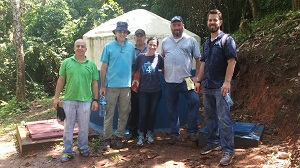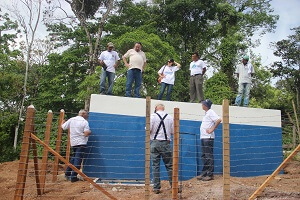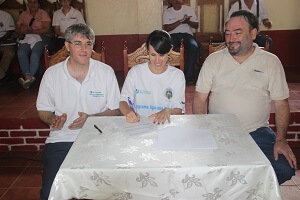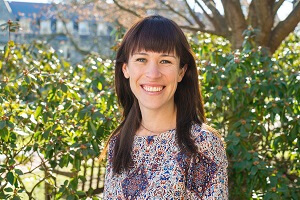Acquisition in Service of the Mission: A Guest Blog by Nora Pillard Reynolds, Co-founder, Water for Waslala
La Piana Consulting is always eager to share stories about collaboration and strategic restructuring for social impact, whether from our clients or others. In this post, we hear from Nora Pillard Reynolds, whose experience as an executive director exploring an acquisition and learning to “let go” will resonate with many nonprofit leaders and changemakers.
By Nora Pillard Reynolds, in collaboration with Robert Gradoville (Water for Waslala board member and Senior Portfolio Manager, IDEO.org), Joshua Briemberg (Regional Director of Latin America & Caribbean, WaterAid), and Rob Bell (Executive Director, El Porvenir)
Every nonprofit should regularly ask themselves: Could acquisition (either to acquire or to be acquired) help us better meet our mission? Based on our firsthand experience, we argue that acquisition should be considered as a strategic option, as opposed to the (all too often) last resort.
Acquisition should always be on the table
I first traveled to Waslala, Nicaragua in 2002 with a group of friends. We did not go to Waslala focused on water, nor did we have any ideas of starting an NGO. But when community members told us about their plans to increase access to clean drinking water, we knew that we could accompany them in reaching their own goals, so we stepped up alongside them. At the time, I had no idea what saying “yes” would mean—co-founding a small nonprofit, Water for Waslala (WfW)—nor that it would shape my personal and professional paths for the next decade and a half.
Over the next ten years, we developed a team of U.S.-based volunteers and Waslalan staff to build WfW into a six-figure operation. By 2012, we had raised over half a million dollars and helped 10 villages to build water systems that brought clean water (just like your local water utility) into the homes of 2,500 Waslalans. Every year, we raised just enough money to push forward on a new project or two—but never much more than we needed.
We all knew what we had to do: grow, increase the pace of work, and finish the job, or peter out and end up in the NGO graveyard; to be seen as just another naïve attempt to save the world.”
—Robert Gradoville, WfW board member 2012-15
We calculated that if we continued to work at the same pace, it would take us 62 years to reach our goal: unacceptable! During a strategic planning session in 2012, we set the goal of achieving our mission—access to clean drinking water for every person in Waslala, Nicaragua (population 65,000)—by 2030. We stepped back to determine how we could grow to accomplish this goal.
Experimenting to scale
Over the next three years, we experimented with three scaling strategies—all with that 2030 goal in mind. We first hired a full-time executive director, then we tried innovating on our field approach to massively reduce costs and speed up impact, and finally we started thinking about getting acquired.
Experiment # 1. In 2012, we decided to hire our first paid U.S. employee, an executive director who would primarily focus on fundraising. It seemed like the obvious solution, and though it would require a big shift, we were hopeful. We spent months hiring and training an executive director that year, but they weren’t able to move the needle on our fundraising. We tried again with another executive director in 2014, but that ended in a similar outcome. We realized that in the long run, even if we did raise the money we needed, too much would have to be used to pay U.S. salaries vs. helping Waslalans—we were just too small an operation to support the overhead of full-time U.S.-based staff.
Experiment #2. In 2014, we thought: What if we could innovate to reduce the cost to provide water to each person? We launched a pilot project to provide water filters on credit to thousands of Waslalans still waiting for water. Instead of using $10 of donations to buy $10 of pipe for a water system, we used maybe $3 to land a partnership with a local bank that was willing to offer water filters to Waslalans on credit; that way, the donation went much further. This approach helped us reach nearly 4,000 Waslalans in just over a year—more than we had reached in our entire history to date! Still, we knew that this approach was a band-aid solution because a water filter has an average life of two years and is different from a sustainable piped water system that provides water to a home 24/7 over years. It still didn’t solve our problem. What we really needed was to scale up our core work.
Experiment # 3. Finally, in 2015, we came up with the idea of trying to find someone to take over our work: someone with better fundraising and an interest in water and sanitation work. We didn’t think of it as selling out, we considered it a strategic partnership to reach scale. We put together a document stating our intention to seek a “strategic acquisition” and started looking for bigger NGOs that might want to take us on. This experiment required us to let go.
Letting go
That summer, we heard from WaterAid, a global nonprofit equipping communities with clean water, sanitation, and hygiene. We spoke with Joshua Briemberg, WaterAid’s Regional Director for Latin America and the Caribbean, and the conversation quickly turned to the details: What would this acquisition look like? How would it happen? Over what time period? Who would need to stay involved?
WaterAid approached El Porvenir, an organization with 25 years experience partnering with the people of Nicaragua to improve their living standards, about the possibility of joining this effort as the implementing partner, which made this a tripartite acquisition. We spent the next year drafting a business case together; bringing legal counsel on board and starting due diligence; agreeing to shared messaging about the possible acquisition for team members, partners, donors, etc.; visiting Waslala together to meet with WfW’s local partners; and having many, many tough conversations.
 (Pictured right, representatives from Water for Waslala, WaterAid, and El Porvenir visited a water system in a community in Waslala in order to learn more about the work of Water for Waslala. Left to right – Junior Gasparini (Waslala Director, Water for Waslala), Rob Bell (Executive Director, El Porvenir), Nora Pillard Reynolds (Co-founder and Executive Director, Water for Waslala), Joshua Briemberg (Regional Director, Latin America and Caribbean, WaterAid), Robert Gradoville (Board member, Water for Waslala).)
(Pictured right, representatives from Water for Waslala, WaterAid, and El Porvenir visited a water system in a community in Waslala in order to learn more about the work of Water for Waslala. Left to right – Junior Gasparini (Waslala Director, Water for Waslala), Rob Bell (Executive Director, El Porvenir), Nora Pillard Reynolds (Co-founder and Executive Director, Water for Waslala), Joshua Briemberg (Regional Director, Latin America and Caribbean, WaterAid), Robert Gradoville (Board member, Water for Waslala).)
After a full year of negotiations—of getting to know each other personally and as organizations—I finally had a decision to make. WaterAid’s board of directors had voted “yes” to take on the operations of WfW, WfW’s board of directors had voted to move forward if I felt comfortable, and they were waiting for me to sign on the dotted line. It was exactly what we had hoped for in so many ways, but I was really afraid of letting go. I was afraid the larger WaterAid culture would ruin everything. I was afraid the quality of work would drop and the passion would fade. I was afraid that my friends and colleagues in Nicaragua would quit, feeling like I sold them out. I was afraid of a lot of things, but I knew WaterAid could also potentially get us what we needed: the funding and oversight required to scale to reach all Waslalans by 2030. In a conversation with Joshua, he understood so many of my fears and hopes for this acquisition, telling me:
“I think you have a decision to make and it’s not one that will be made in a SWOT analysis. Are you ready to let go a bit of what’s been built? It might lose some of the local character because the heart gets spread out…it’s a bigger family.”
On April 1, 2016, one year after deciding to explore acquisition, I took a deep breath and signed. WfW was acquired by WaterAid and El Porvenir, forming the Agua Para Waslala Program Alliance, aimed at achieving universal access to water, sanitation, and hygiene in the municipality of Waslala, Nicaragua by 2030.

(Pictured above, Transition 1 – Representatives from Water for Waslala, WaterAid, and El Porvenir visit the recently constructed water system in a community in Waslala.)

Pictured above, Transition 2 – Official transition ceremony in Waslala, Nicaragua. Symbolic signing of the transition agreement. Left to right – Rob Bell (El Porveni), Nora Pillard Reynolds (Water for Waslala), and Joshua Briemberg (WaterAid).)
Acquisition is just the beginning
Our progress as of spring 2018 (two years after transition) is marked by a dramatic increase in funds raised for Waslala and the number of Waslalans reached with access to clean drinking water. In the year following acquisition, we raised $380,000—more than the total amount raised in the previous five years combined—and reached as many Waslalans as we did over the past three years combined.
Despite this success, we encountered many challenges during the year after acquisition, including leadership turnover in Waslala; unexpected lag time in project implementation; culture differences between the organizations; and misaligned expectations in the transition of U.S. operations. While we weathered many challenges together, most were concentrated in the area of U.S. operations (donor engagement, stewardship, and retention). As international NGOs, all three organizations focus heavily on in-country work; however, it is crucial to consider U.S. operations and intentionally incorporate the U.S.-based team members throughout the entire acquisition process to ensure smooth transition.
Letting go was hard. But, if we held on, WfW would have continued to make slow progress and it would be impossible to reach our mission (at least in our lifetimes). Instead, that audacious goal we set in 2012—to finish our mission and reach all Waslalans with clean water by 2030—is now possible as a result of acquisition.
Was it the right decision? Three years after initiating the acquisition process and two years after signing on the dotted line, my answer to this question is simply…yes.


Comment section